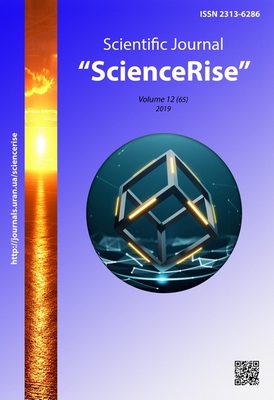Оптимизация процесса флокуляции очисктки промышленных сточных вод
DOI :
https://doi.org/10.15587/2313-8416.2019.189708Mots-clés :
флокуляция, агрегатообразование, прочность агрегатов, скорость осаждения, оптимизация, гидромеханическое разрушение флокулRésumé
Исследовано влияние концентрации твердой фазы и расхода флокулянта на изменение скорости оседания твердой фазы и прочность флокул. Предложена методика оптимизации параметров агрегатообразования и повышения прочности флокул после гидромеханических воздействий, учитывающая концентрацию твердой фазы и расход флокулянта. Было установлено, что оптимальные условия агрегатообразования возможно обеспечить путем минимизации гидромеханических воздействий на флокулы, а так же создания наилучших условий флокулообразования. Среди путей оптимизации процесса анализировались способы влияния на эти факторы за счет технологических особенностей введения процесса, таких как корректировка концентрации, скорость транспортировки сфлокулированного шлама, время перемешивания
Références
Walsh, M. E., Zhao, N., Gora, S. L., Gagnon, G. A. (2009). Effect of coagulation and flocculation conditions on water quality in an immersed ultrafiltration process. Environmental Technology, 30 (9), 927–938. doi: http://doi.org/10.1080/09593330902971287
Nandy, T., Shastry, S., Pathe, P. P., Kaul, S. N. (2003). Pre-treatment of currency printing ink wastewater through coagulation-flocculation process. Water, Air, and Soil Pollution, 148 (1/4), 15–30. doi: http://doi.org/10.1023/a:1025454003863
Laue, C., Hunkeler, D. (2006). Chitosan-graft-acrylamide polyelectrolytes: Synthesis, flocculation, and modeling. Journal of Applied Polymer Science, 102 (1), 885–896. doi: http://doi.org/10.1002/app.24188
Gurse, A., Yalcin, M., Dogar, C. (2003). Removal of Remazol Red RB by using Al(III) as coagulant-flocculant: effect of some variables on settling velocity. Water, Air, and Soil Pollution, 146 (1/4), 297–318. doi: http://doi.org/10.1023/a:1023994822359
Shkop, A., Tseitlin, M., Shestopalov, O. (2016). Exploring the ways to intensify the dewatering process of polydisperse suspensions. Eastern-European Journal of Enterprise Technologies, 6 (10 (84)), 35–40. doi: http://doi.org/10.15587/1729-4061.2016.86085
Shkop, A., Tseitlin, M., Shestopalov, O., Raiko, V. (2017). Study of the strength of flocculated structures of polydispersed coal suspensions. Eastern-European Journal of Enterprise Technologies, 1 (10 (85)), 20–26. doi: http://doi.org/10.15587/1729-4061.2017.91031
Wang, Y., Chen, K., Mo, L., Li, J., Xu, J. (2014). Optimization of coagulation–flocculation process for papermaking-reconstituted tobacco slice wastewater treatment using response surface methodology. Journal of Industrial and Engineering Chemistry, 20 (2), 391–396. doi: http://doi.org/10.1016/j.jiec.2013.04.033
Bridgeman, J., Jefferson, B., Parsons, S. A. (2009). Computational Fluid Dynamics Modelling of Flocculation in Water Treatment: A Review. Engineering Applications of Computational Fluid Mechanics, 3 (2), 220–241. doi: http://doi.org/10.1080/19942060.2009.11015267
Bache, D. H. (2004). Floc rupture and turbulence: a framework for analysis. Chemical Engineering Science, 59 (12), 2521–2534. doi: http://doi.org/10.1016/j.ces.2004.01.055
Hogg, R.; Dobias, B., Stechemesser, H. (Eds.) (2005). Flocculation and dewatering of fine-particle suspension. Coagulation and flocculation. Boca Raton: CRC Press, 805–850. doi: http://doi.org/10.1201/9781420027686.ch12
Shestopalov, O., Briankin, O., Tseitlin, M., Raiko, V., Hetta, O. (2019). Studying patterns in the flocculation of sludges from wet gas treatment in metallurgical production. Eastern-European Journal of Enterprise Technologies, 5 (10 (101)), 6–13. doi: http://doi.org/10.15587/1729-4061.2019.181300
Trinh, T. K., Kang, L. S. (2011). Response surface methodological approach to optimize the coagulation–flocculation process in drinking water treatment. Chemical Engineering Research and Design, 89 (7), 1126–1135. doi: http://doi.org/10.1016/j.cherd.2010.12.004
Shestopalov, O., Rykusova, N., Hetta, O., Ananieva, V., Chynchyk, O. (2019). Revealing patterns in the aggregation and deposition kinetics of the solid phase in drilling wastewater. Eastern-European Journal of Enterprise Technologies, 1 (10 (97)), 50–58. doi: http://doi.org/10.15587/1729-4061.2019.157242
Téléchargements
Publié-e
Numéro
Rubrique
Licence
(c) Tous droits réservés Oleksіi Shestopalov , Oleksandr Briankin, Nadegda Rykusova, Oksana Hetta 2019

Cette œuvre est sous licence Creative Commons Attribution 4.0 International.
Our journal abides by the Creative Commons CC BY copyright rights and permissions for open access journals.
Authors, who are published in this journal, agree to the following conditions:
1. The authors reserve the right to authorship of the work and pass the first publication right of this work to the journal under the terms of a Creative Commons CC BY, which allows others to freely distribute the published research with the obligatory reference to the authors of the original work and the first publication of the work in this journal.
2. The authors have the right to conclude separate supplement agreements that relate to non-exclusive work distribution in the form in which it has been published by the journal (for example, to upload the work to the online storage of the journal or publish it as part of a monograph), provided that the reference to the first publication of the work in this journal is included.

